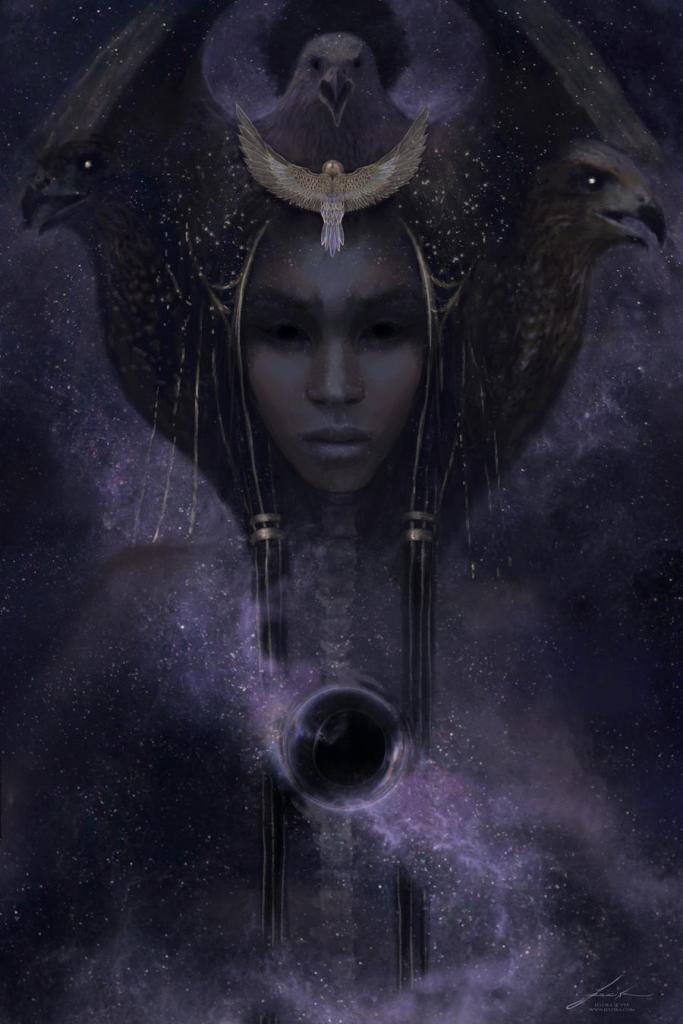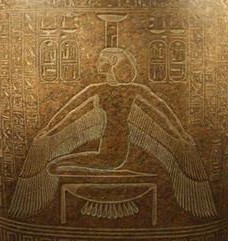
Let us have a little Nephthys today. It is early September and there is melancholy in the air. Not to mention that there is some serious s*it going down all around us. Sometimes we look to our Dark Goddesses in such times.
And sometimes, when we look to Them, we find surprising things.
For instance, older Egyptological books informed us that Nephthys was never worshipped alone and had no temples of Her own. But that was only because they hadn’t found any yet.
We now know of several Nephthys temples, a smaller New Kingdom one within a Set temple precinct at Sepermeru, halfway between Heracleopolis and Oxyrhynchus (where that huge cache of texts, including magical texts and a praise of Isis was found), and a Ptolemaic and Roman-era temple at Komir, near Esna.
In Her Komir (Egy. Pr Myr) temple, there is a lengthy hymn to Her that identifies Her with many other Goddesses, just as Isis is known by many names. She is “the Great, the Most Excellent, dwelling in the Beautiful Country—the abode of Her brother Osiris, Who comes to life again in Her, She Who renews for Him the body that once was, in Her name of Renewing of Life.” She is invoked as Meshkenet, the Birth Goddess, Hathor, Mistress of Drunkeness and Joy, Tefnut “in the moment of Her wrath,” and Seshet, Lady of Writing and “of the Entire Library.” She is Mut and Mafdet and Meret and Heket. She is the one Who “utters divine decrees, Great of Magic, who rules in the Mansion of Archivists.” She is Excellent of Kindness and unites Herself with Ma’et. She is the Mother of Amun and the Daughter of Re. She is Mighty, Formidable, Beautiful.
In a papyrus known as the Book of Hours—Ptolemaic and probably from Memphis—praises are recorded for a select group of Deities, including Nephthys. There She is called Kindly of Heart, Mistress of Women, the Valiant, the Strong-Armed, Who Begat Horus, Potent of Deeds, the Wise, the Acute of Counsel, and the Sad at Heart.

Interestingly, Her epithets in this papyrus do not parallel those of Isis, Who is In All that Comes Into Being at Her Command, Lady of What Exists, Sharp of Flame, Who Fills the Land with Her Governance, Who Pleases the Gods with What She Says, the Savior, Isis-Bast and Isis-Sakhmet, the Sister of the Great One, Who Comes at Call, and the Living North Wind.
As Twin Goddesses, Isis and Nephthys are often called “the two” this or that. You’ll find a list of those twosome names in a previous Isis and Nephthys post here. We often think of Isis as the Bright Twin and Nephthys as the Dark Twin. And it’s true. Sort of.
For instance, the Pyramid Texts instruct the deceased king to
Ascend and descend; descend with Nephthys, sink into darkness with the Night-barque. Ascend and descend; ascend with Isis, rise with the Day-barque.
Pyramid Text 222
The Two Goddesses bear light and dark children to the same God. Osiris fathered the bright God, Horus, with Isis while with Nephthys, He fathered the dark God, Anubis. The Two Goddesses also manifest their Divine power differently. While Isis guides and sheds light on the hidden paths of the Otherworld, the Coffin Texts tell us that Nephthys speaks and they are obscured: “Hidden are the ways for those who pass by; light is perished and darkness comes into being, so says Nephthys.”
While Isis summons the Barque of the Day, Nephthys is “a possessor of life in the Night-barque.” As in Pyramid Text 217, Nephthys is paired with Set, a God of dark moods and dark reputation and associated with Upper Egypt, while Isis is paired with the benevolent God Osiris and connected to Lower Egypt. In the tomb of Tuthmosis III, Nephthys is said to be the Lady of the Bed of Life, by which was meant the embalming table. She is also Queen of the Embalmer’s Shop. Plutach preserves the tradition that Nephthys was associated with the desert and the fringes of the earth, while Isis is that part of the earth made fertile by the Nile.
But wait. As with most Things Egyptian, it’s not that simple. It’s not that black-and-white nor dark and light.
Isis is not just about rebirth and sunrise. She is also the Great Mooring Post, the one Who calls each of us to our deaths. She is the Goddess “ruling in the perfect blackness” of the Otherworld and She has Her own wrathful and fiery moods. Nephthys, on the other hand, is not only about descent in the Night-barque. She is right there with Isis at the sunrise rebirth. And She is a Goddess for Whom festivals of drunkenness and joy were celebrated. She is the Lady of Beer and while Isis, too, can be so called, I know of no festivals of Divine inebriation celebrated for Her, even given Her close connection to Hathor, the original Queen of Divine Drunkenness.
The Two Sisters are not so much opposites as complements to each other. It is interesting that Isis and Nephthys seem to have become attached to different aspects of Hathor in Their association with Her. Sad at Heart Nephthys became connected with Hathor, Lady of Joy and Divine Intoxication. Lady of Governance Isis became connected with Hathor the soft-eyed Cow Mother, the Mother of the God, and the Lady of Amentet. Yet, as always, these roles are fluid and the Two Sisters flow into one another, even as They express different aspects of Their Divinity.
People sometimes wonder whether Isis and Nephthys are two different Goddesses or one Goddess? For me, the answer is, “Yes. And no.” They are One and They are Two. In my personal work with the Two Sisters, I can’t say that Nephthys feels very much different than Isis (though there are differences), but that may be because I pay a lot of attention to Isis’ own darker aspects. That admission inspires me to take some time this weekend to honor Nephthys, Excellent of Kindness, and see what more She may wish me to know.



Many information about this Goddess aspect. Love it. Very helpful
As always, this is very timely for me. My own experience with Nephthys has grown into a true relationship with Her, one which I very much desire to cultivate . As is also no surprise, my relationship with Isis has deepened even more as my relationship with Nephthys has progressed. I agree with you completely: They are very much One, just as They are very much Two. I’d simply say that I love Them Each and I love Them Both.
Yes, so exactly 😉